
A collection of fourteenth- to seventeenth-century earthenware and stoneware sherds found in London. (Ex-Burnett Collection; photo, Gavin Ashworth.) For a museum registrar, an embryonic storage problem; for a ceramics historian a crock of gold.
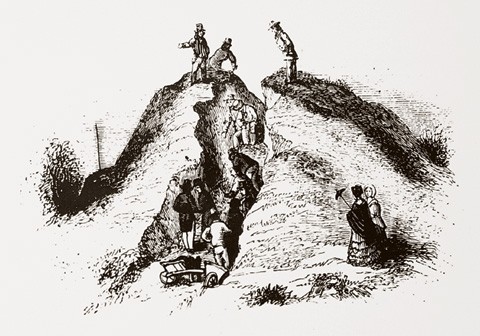
Engraving, England, nineteenth century. (Illustrations courtesy of the author unless otherwise noted.) Ceramic collecting Victorian style: ruining a Bronze Age burial mound.
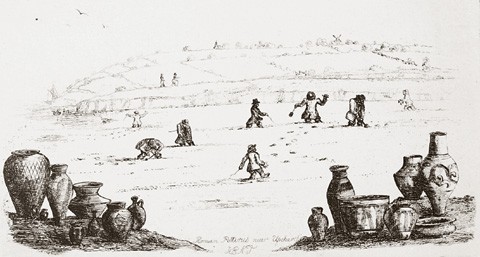
Engraving, England, nineteenth century. Sending one’s servants groping for Roman pots in the mud of the Kentish marshes.
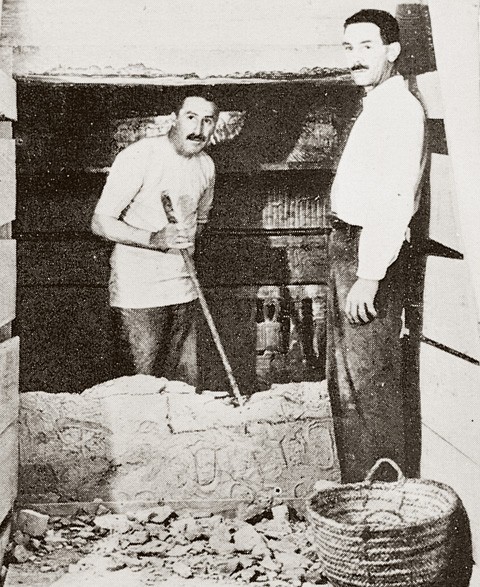
Howard Carter and Arthur Mace, 1923. One the robbers missed. Carter and Mace are demolishing an inconvenient wall in the tomb of Tutankhamun.

Giovanni Belzoni’s watercolor showing his workmen moving the “Young Memnon” from Thebes, 1816.

Stone sculpture. With help from friends in high places, British Consul General Henry Salt made this delivery to the British Museum in 1817.
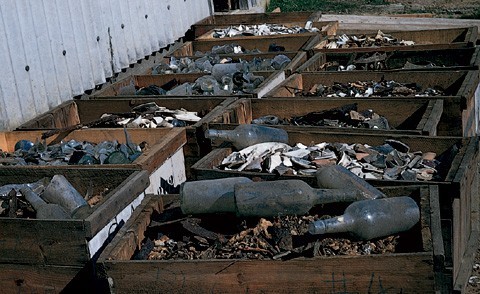
Archaeological artifacts at Colonial Williamsburg. An awkward inheritance: part of the unwashed and unloved legacy of digging in Williamsburg prior to 1957.
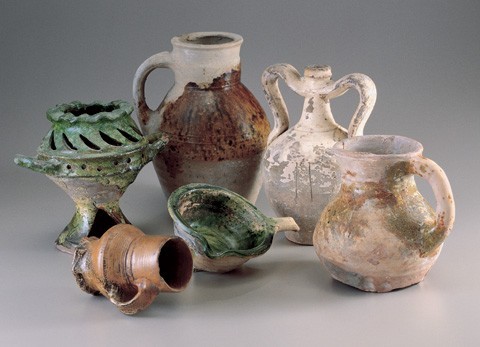
A group of sixteenth- and seventeenth-century earthenware and stoneware vessels. (Noël Hume Collection; photo, Gavin Ashworth.) Like daffodils and oak trees, these are the kinds of ceramics that only come out of the ground.
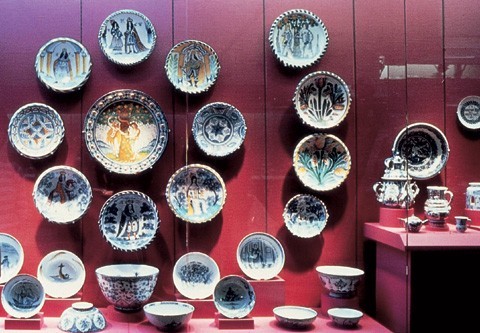
Museum exhibit of seventeenth- and eighteenth-century English delftware, a presentation designed to display more than to instruct. (Courtesy, Colonial Williamsburg.)
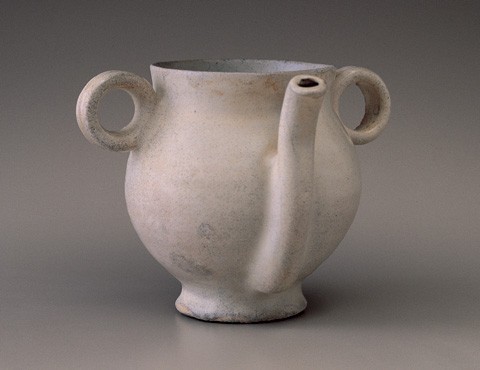
Caudle or posset pot, London, ca. 1640. Tin-glazed earthenware. H. 5 1/2". (Noël Hume Collection; photo, Gavin Ashworth.) The importance of a ceramics collection depends less on what it cost than on what its pieces have to say about themselves and the times in which they were made and used (see figs. 11 and 12).

Reverse of plate, Staffordshire or Yorkshire, ca. 1780. D. 9 1/2". Creamware. (Noël Hume Collection; photo, Gavin Ashworth.) This plate bears the ghostly imprint of the painted decoration from a plate stacked beneath.
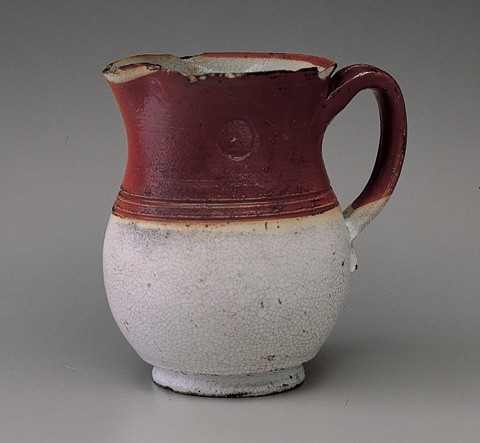
Jug, London, early eighteenth century. Stoneware with both salt-glaze and tin glaze. H. 5". (Noël Hume Collection; photo, Gavin Ashworth.)

A Romano-Gaulish Samian ware bowl. The kind of object on whose exhibit case small boys were supposed not to breathe.
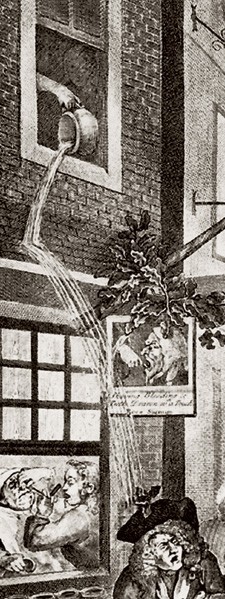
Detail from William Hogarth’s (1697–1764) Night from the series The Four Times of the Day, 1739.
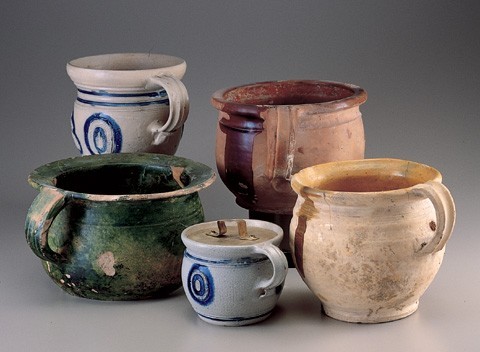
Group of seventeenth- and eighteenth-century stoneware and earthenware chamberpots. (Noël Hume Collection; photo, Gavin Ashworth.) Both Hogarth (fig. 14) and Gilray (fig. 16) portrayed these unmentionable ceramic vessels with disarming candor.
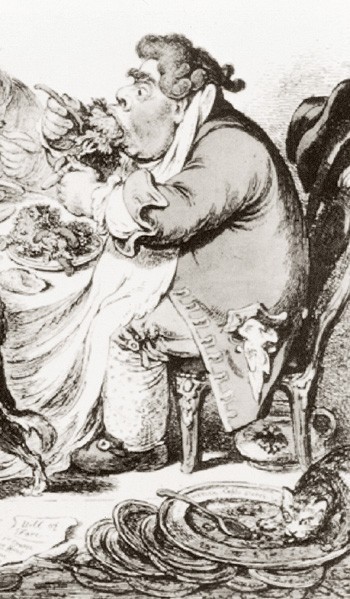
Detail from James Gilray’s (1757–1815) Germans Eating Sour-Krout, colored etching, 1803.
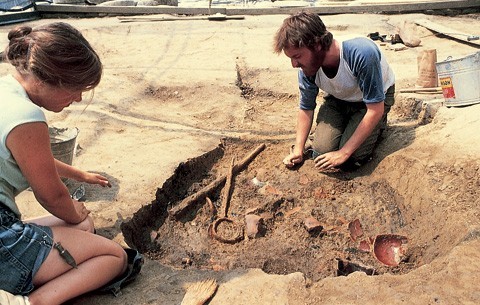
Archaeological excavation of earthenware fragments from the production of Virginia potter Thomas Ward at Martin’s Hundred, Virginia, ca. 1622.
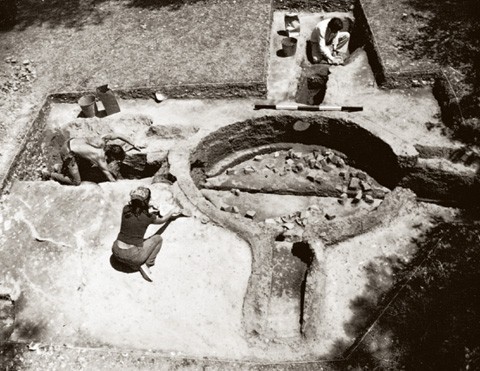
Photograph of archaeological excavation at Morgan Jones Kiln Site, Westmoreland County, Virginia, ca. 1672. (Photo, William Kelso.)
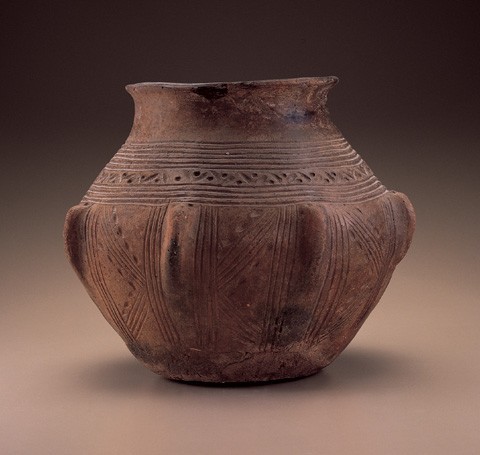
Cinerary urn, Anglo-Saxon, 500–600 a.d. Unglazed earthenware. H. 10 3/8". (Courtesy, Chipstone Foundation; photo, Gavin Ashworth.) This example is not every collector’s dream pot.

Dish, Rouen, France, ca. 1780. Tin-enameled earthenware. L. 13". (Noël Hume Collection; photo, Gavin Ashworth.) Even this modest eighteenth-century dish becomes a marketable celebrity once it gets its picture in the paper.

Pipkin, probably England, 1640–1670. Lead-glazed earthenware. H. 6 3/4". (Noël Hume Collection; photo, Gavin Ashworth.)

Graybeards galore. Museum storerooms were and are replete with pots the public never sees. (Photo, William Gordon Davis.)
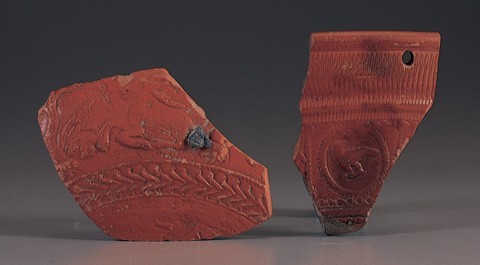
When a Roman someone cared enough to mend her very best. (Noël Hume Collection; photo, Gavin Ashworth.)
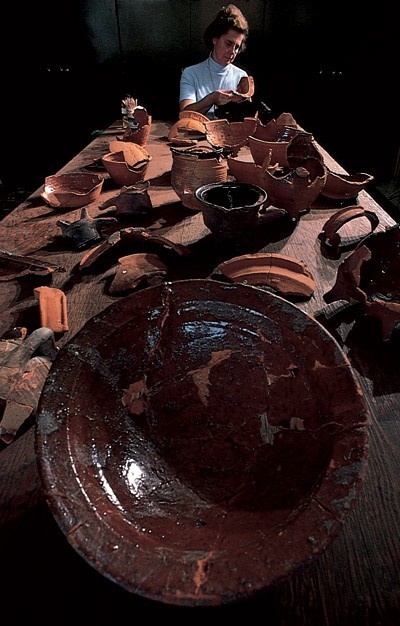
When Virginia potter Thomas Ward tried to fix his worst. (Courtesy, National Geographic Society; photo, Ira Block.)
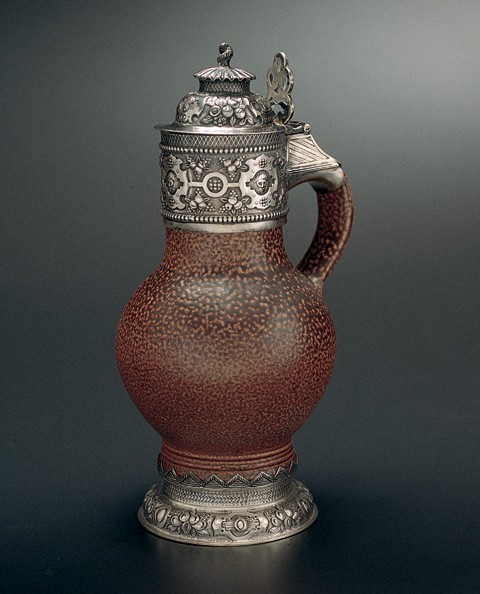
Jug, probably Doulton, ca. 1910. Stoneware with silver mounts. H. 11 3/4". (Noël Hume Collection; photo, Gavin Ashworth.)To pull or not to pull the petals off a gilded lily? That is the question.

Colored engraving of a Mender of Porcelain, London, England, 1799. (Private collection; photo; Gavin Ashworth.)
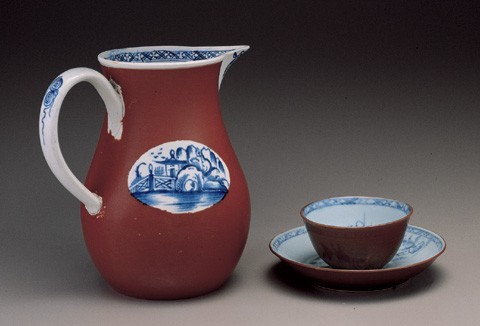
(Left) Jug, Staffordshire or Yorkshire, ca. 1785. Pearlware. H. 6 3/4". (Right) Tea bowl and saucer, Ching-tê-chên, China, ca. 1751. Hard-paste porcelain. (Noël Hume Collection; photo, Gavin Ashworth.) Pearlware and porcelain in the “Batavian” style, yet neither piece was made there.
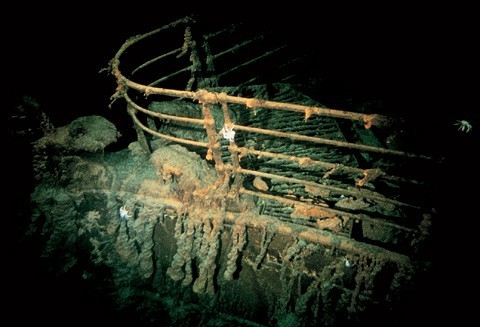
Photograph of the bow of the Titanic. (Courtesy, Woods Hole Oceanographic Institution.) Asleep in the deep, R.M.S. Titanic as first seen—before a Virginia judge issued a license to an entertainment company to remove artifacts.

Underwater photograph of a Titanic chamber pot. (Courtesy, Woods Hole Oceanographic Institution.) What price would a dealer put on this chamber pot, which might have been used by John Jacob Astor?

A group of earthenwares and stonewares excavated from the Mary Rose (1545). (Courtesy, Margaret Rule.) Although these vessels were brilliantly excavated and conserved, like the Titanic, the Mary Rose was a mass grave site.

Underwater photograph of porcelain cargo. (Courtesy, Christie’s.) Without saving the shreds of their packing material, were the Geldermalsen’s porcelains worth salvaging?
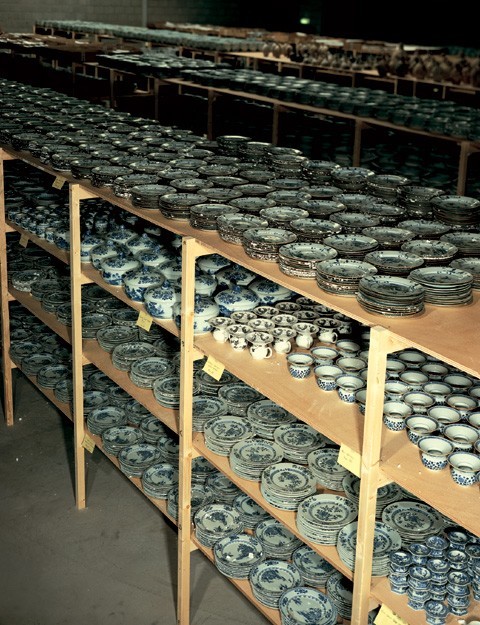
Photograph of the Geldermalsen’s porcelain at Christie’s Amsterdam. (Courtesy, Christie’s.) Nearly two hundred years late, the porcelain awaited buyers, few of whom, if any, arrived wearing knee-britches or wigs.

Earthenware sherds from a ca. 1760 French wreck. (Sherds courtesy of E. B. “Teddy” Tuckev; photo by author.) Because they were not found by professional archaeologists, these fragments have been deemed worthless.
Collectors of fine furniture, silver, paintings, textiles—indeed, more or less everything other than ceramics—represent a small but clearly defined segment of a nation’s population. But pot people are much more diverse in their approaches and as collectors are likely to be more controversial. They range all the way from connoisseurs of specific wares who will pay a minor king’s ransom for a single delftware plate to those who desecrate Indian graves or delve into garbage dumps in search of not very old stoneware beer bottles. Somewhere in between stand the archaeologists for whom pottery and porcelain are—or should be—the warp and weft of their profession. To their ranks belong the practical students of ceramics whose goal is to understand manufacturing processes and thereby date their sherds, as well as those with an anthropological approach who see pottery as a means of picking apart the people of the past to see what made them do what they did and think what they thought. By and large, however, today’s archaeologists are more gatherers than collectors. They do not much care what happens to their pots once they have studied and learned from them (fig. 1). This is understandable because ownership of numerous bags of potsherds can be more of a storage liability than a curio cabinet asset.
Archaeologists of yore—which means any time but yours—were less interested in fragments than they were in whole vessels. Only relatively recently have we seen a proliferation of professional archaeologists for whom emotional detachment is an academically correct prerequisite. The joy of discovery, the thrill of reaching out to come within a hand’s touch of the past or to stand on the very ground that someone memorable once trod, these are to be expected of amateurs more schooled in the darkness of movie theaters than in the sterile objectivity of the classroom. Nevertheless, the history of archaeology has been umbilically linked to collecting, and those who dug, or who paid others to dig, did so to acquire for their sponsors or for themselves.
The ethics of possession can be debated ad infinitum, and those of us with heads big enough to wear two hats can make the case both for and against collecting. I know that I can, and in consequence I am sympathetic rather than antagonistic toward those who believe that collecting excavated antique ceramics is snatching plums from the cake of time. Far less debatable is archaeology’s lack of interest in providing information to help collectors better understand what they have. With rare exceptions, archaeological reports are written to be read only by archaeologists, and even within those parameters, many American reports have paid only lip service to artifacts. Relegated to the back, shown only in photographs, and circulated in photocopies that reduce the images to black blobs of varying density, potsherds so illustrated are of no use to anyone. Then, too, computer technology has allowed report compilers to substitute for drawings or even for fuzzy photos, numerical and distributional printouts. Such reporting implies an arrogance that says “I don’t need to show you what I’ve found. You’ll just have to take my word for it that my identifications and interpretations are right.”[1]
I would argue that in the field of ceramic history, particularly in those centuries that fall within the sphere of American cultural history, archaeologists and collectors have much to teach each other. For my part, I know that virtually every time I visit a private collection I learn something new—often something that calls for a reassessment of assumptions I have previously considered carved in stone.[2]
Through the centuries preceding, perhaps, the mid-twentieth, the history of European ceramic collecting has been fairly equally divided between chapters penned by private and by public collectors. On the one hand stood the country clergyman who set his parishioners to digging into ancient British burial mounds in search of pots to grace his cabinet (figs. 2, 3), and on the other were great museums whose trustees bankrolled archaeological explorers to ransack the ruins of Nineveh or to haul treasures from the depths of Theban tombs (fig. 4). Today, of course, such practices are deemed to be several light years beyond the pale. But no matter how deplorable we may think our predecessors were, the fact remains that very few museums are standing in line to return their ill-gotten goodies to demanding nations that, in the first instance, gave firmans to the diggers and assisted them with the packing and shipping (figs. 5, 6).
One might suppose that today’s archaeological museums no longer desire to expand their collections and are content to let their galleries remain forever static. While that may be true of some, others retain an ethical loophole that allows artifacts to slip in by merit of having been found by professional archaeologists. The rationale is twofold: first, that the objects are being secured for the public good, and second, that the digging has been conducted to a sufficiently high standard to ensure that no related information has been lost. These are praiseworthy goals, though some might question what the museums do with the information so carefully and expensively garnered.[3]
In the summer of 1999, the Museum of London’s archaeological holdings included 120,000 boxes of unprocessed artifacts, most of them potsherds.[4] On a lesser scale, museums everywhere that accept archaeological material (there often being nowhere else to house it) have storerooms stacked with boxes retained only because they ought to be. In 1957 when I took charge of Colonial Willamsburg’s archaeology department I recall being appalled to find a bus garage stacked with crates of unwashed artifacts from twenty years of digging, and being advised by my superior to secretly dump them into the York River (fig. 7). My outrage was real but, in retrospect, ill-founded. Saved without any detailed archaeological context, the material was worthless, its messages from the past torn up the moment it was stripped from its stratigraphic matrix. What, if anything, does all this have to with the collecting and studying of ceramics in the context of American decorative arts? I would answer: A great deal, particularly when the history of imported British ceramics is in review. It is fair to say, I think, that 90 percent of all British pottery dating prior to the mid-seventeenth century has come not from the cellars of foreclosed mansions but out of the ground. Be it Bronze Age burial urns, Roman kitchen wares, medieval jugs, or Elizabethan porringers, virtually all have survived through having been buried with their owners or lost down their wells, thrown into castle moats, or broken and tossed into trash pits (fig. 8). Without them, more than three thousand years of British pottery would be a closed book.
Most famous, privately built ceramic collections now in museums—such as the Burnap Collection in the Nelson–Atkins Museum of Art in Kansas City, the Schreiber Collection in London’s Victoria and Albert Museum, and the Glaisher Collection in the Fitzwilliam Museum at Cambridge—all begin with specimens older than their collectors’ principal focus. This is as it should be, for as in all else, and for better or sometimes worse, we live in an evolving world. Achievement can only be measured against the yardstick of what went before.
The masterpiece mania that across the years has driven the acquisition policies of so many great museums was put into words in a 1913 position paper from the Victoria and Albert Museum’s ceramics curator, Frank Church. Addressing it to the “Sub-Committees upon the Principal Deficiencies in the Collections,” and quoting the Chinese philosopher Hseih Ho, he asserted that the first principle of any good collection has to be the acquisition of masterpieces. These alone, he added, “are the source of inspiration—and by the number of its masterpieces a collection is finally judged” (fig. 9). Reading on, it becomes clear that Church’s concern was not only for the august reputation of the collection but for that of its custodian. Curators, he insisted were “gifted by nature to feel the difference between a masterpiece and an average work—and entitled after years of training to become heads of departments.” He also believed that, by restrictive budgeting, curators would be forced to “fall back upon what is cheap...the fatal snare of the second-rate collector” who “soon finds his collection déclassé.”[5]
No one will deny that to be important a collection must contain specimens of above average significance and interest. But that does not mean that they have to be masterpieces. A hitherto unrecorded shape of an undecorated delftware posset pot (fig. 10), a plate with a design on its back that shouldn’t be there (fig. 11), or a pitcher half one ware and half another (fig. 12), indeed any vessel that tells us something we did not already know, can elevate a ho-hum collection to memorable heights.
Taken literally, a masterpiece is a test product of a journeyman in any craft deemed to be of sufficient quality for his peers to accept him as a master of his trade. Although London was the center for the quality control in most seventeenth-century trades and housed worshipful companies of dozens of crafts from apothecaries to woolpackers, the essential craft of the potter was conspicuously absent. Used more loosely, the word MASTER-piece was defined in Nathaniel Bailey’s Etymological English Dictionary (1749 edition) as “a most exact or excellent Piece of Workmanship in any Art.” But how does one judge excellence?[6]
More often than not we are content to take someone else’s word for it. To do otherwise, it is beholden upon us to have seen and studied enough in the same genre to determine for ourselves that this or that example is superior to any other. Fortunately for our lexicon of superlatives, few ceramic objects aspire to masterpiece status. Besides, a pot that we now consider superior to all others in its class may not have been so considered in the context of its own time. I venture to suggest, therefore, that the rightly respected Frank Church had it wrong and that his successors’ buying policy, which reflected his views, resulted in exhibitions that gave a disconcertingly distorted view of ceramic history. That elitist outlook required visitors to be content to accept the premise that curators of long experience (as well as of tooth) were indeed “gifted by nature” to tell the museum visitors what they should admire. The notion that the public deserved to be given the opportunity to make its own determination by seeing the great alongside the not-so-great (and even the positively awful), would have had curators handing in their resignations while reaching for their top hats. Not only would such ceramic diversity have been déclassé, it would have taken up space otherwise available to be packed pot-to-pitcher with yet more masterpieces.
I well remember asking my boss and chief curator at London’s Guildhall Museum why it was necessary to write labels in abbreviated Latin that only a classicist would understand. “Young man,” he replied, “it keeps small boys from coming in and breathing on the cases.” He should, of course, have been right. But he wasn’t. Small boys did come in, and although they ignored the labels, they were thrilled to see the pots and even sat down to draw them. There was magic in the thought that eighteen hundred years ago (way beyond 1066 and All That) their ancestor had been eating from cups and bowls far more decorative than those the kids had at home (fig. 13).[7]
Just as English-speaking playwrights like Eugene O’Neil and John Osborne lured us toward the kitchen sink and away from “Tennis anyone?” drawing-room comedy, so the warts-and-all anti-establishment philosophies of the 1960s have invaded the museum world. At Colonial Williamsburg, as elsewhere, the gentility of the post–World War II generation, with its emphasis on bowing and ball gowns, has been replaced by interpretations that call a powder room a privy and a slave a slave. In so changed an atmosphere the lead-glazed chamber pot and close stool pan have gained an acceptance (if not admiration) denied them since the days of Hogarth, Rowlandson, and Gilray (figs. 14,15,16).
In England, as in America, students of everyday earthenwares and stonewares are for the first time studying them with the care and enthusiasm hitherto devoted to naught else but porcelain and the best of Wedgwood. Kiln sites of lowly wares—for instance, those of the sgraffito slipwares of Donyatt and the yellows and greens of Elizabethan potters working in Surrey and Hampshire—are being excavated skillfully in England while comparable factories have been explored in Martin’s Hundred near Williamsburg in Virginia (fig. 17), and in the same state’s Westmoreland County (fig. 18). In England, too, the stoneware factory of John Dwight of Fulham has been extensively excavated and published, while the same has been true of earthenware and stoneware manufacturer William Rogers, whose kilns at Yorktown have been explored and reported on. At last the common man and his common wares are becoming respectable. But are they collectable?[8]
As the lad from Stratford-on-Avon would have us say, “Aye, there’s the rub!”
Collecting interest is fostered and sustained by availability. Intact but plain earthenwares lacking the “keep me” factor that discouraged estate strippers from tossing away decorated or dated examples, have become rarer than “masterpieces.” And what we cannot buy, we tell ourselves we do not want (fig. 19). I know that in my own collecting career I have shifted from one ware to another as examples became harder and harder to find or were priced out of my league. A French faience dish I had bought for two dollars before unwisely writing about it in Antiques prompted a dealer-reader to offer me another just like it at two hundred dollars. Alas, these heavy and none-too-attractive dishes have never reverted to what I still consider a fair, two-bucks price (fig. 20).[9]
Like Amsterdam today, London between the two World Wars was a prime source for intact sixteenth- and seventeenth-century pottery found on city construction sites. In those days the London Museum’s agent, G. F. Lawrence (who doubled as a dealer), became known to every building-site laborer as “Stony Jack,” to whom they would trade dug-up pots for beer money. In the same period, Frank Lambert, the city’s own Guildhall Museum clerk (the name “curator” being thought too elevated) would also buy from laborers. However, the old hands assured me that Jack paid best. Nevertheless, both museums greatly enlarged their collections at that time, and those pots that slipped by them wound up in street markets or were sold directly to “gents” who met the laborers and “wetted their whistles” in city pubs.[10]
Several pieces in my collection bear faded labels telling me that they were found on this site or that street, information which, to me, enhances their interest and is carefully recorded in the hope that it will always remain with them. But while such knowledge is better than none, it has little probative value. A mid-seventeenth-century earthenware pipkin in the collection contains a shriveled label with a message typed in red telling a previous owner (who wisely copied it before it became illegible) that the vessel was “a cooking pot found 5ft from surface in gravel while excavating for foundations at Upper Smithfield new Good Depot,” and was “stated to be 15th century manufacture.” Because most of London is built on Thames Valley gravel and the label does not define what was meant by “surface” or how the pot got to be five feet down, the information is worthless (fig. 21). The same is true of the vast majority of the anonymously sourced early ceramics in the collections of the now combined London and Guildhall Museums (fig. 22).
Unlike the masterpiece-hungry decorative art museums, the London history museums became far stronger in their medieval and immediately post-medieval earthenware and stoneware collections than in the later white saltglaze, creamware, pearlware and the like—and for a very simple reason: To the salvaging, beer-money-expectant laborers, such wares did not look old enough to be worth anything. Besides, with so many decorative examples surviving above ground, the finders were right. No one wanted a cracked, run-of-the-mill creamware plate, and nobody cared to rub the dirt off the back of it to reveal an unrecorded potter’s mark before throwing it aside. No less saddening is the fact that to the eye of a builder’s laborer, anything broken was not worth saving. Consequently, countless highly significant ceramic objects that were uncovered and could have been saved were discarded, while complete pots with little or nothing new to say were salvaged and sold.
My wife’s and my eighteenth-century and later collecting began around 1958 when, after moving to the United States, we realized that we had much to learn and needed to do it in a hurry. In those days, neither curators nor collectors could abide cracks or chips. I clearly remember Audrey airily dismissing a splendid David Rhodes-style creamware teapot because its spout was chipped. A month later, having thought better of it, we returned to the shop hoping to find it still there. It was not. Around that point in our collecting we realized that for study or teaching purposes, cracks and chips translated into both “desirable” and “affordable.” But times change, and looking today through the catalogs of Sotheby’s or Christie’s one finds that terms like “minor damage” and “some restoration” are no longer marks of Cain and do not betoken sale-room bargains. Since the 1950s, a proliferation of private collectors on both sides of the Atlantic, as well as in the Far East, has thinned out the good stuff to a point where yesteryear’s second rate has moved to front and center. Besides, there are restorers who can mix plaster or plastic as readily as I can mix a metaphor, thereby turning a ceramic sow’s ear into a pearl of great price.
The assumption that a bowl, a dish, or whatever that was repaired in its useful lifetime is thereby rendered undesirable, depends very much on one’s reason for collecting. My own view—and throughout this essay these are my own views—is that such repairs can make an object more rather than less interesting. Nevertheless, I cannot deny that there is a significant difference between an original repair and one made after an object became a carelessly handled antique.
When a Roman era inhabitant of Britain dropped his or her Samian ware bowl and sent it to the repairer to be drilled and lead riveted, we know with absolute certainty that it had been sufficiently valued to merit such attention (fig. 23). But on what, one asks onself, was that valuation based? Did the bowl have sentimental value? If so, what do we know about sentimentality in Roman Britain? Or were bowls of this shape in such short supply that it was easier and cheaper to mend the old? Or was it a question of money? What would a Samian bowl have cost at the end of the first century a.d.—a silver denarius, a bronze sestertius, or a humble copper quadrans? We may never learn the answer, but the very act of wanting to do so breathes new life into a dead potsherd.[11]
I have not found evidence of repairing among medieval earthenwares. Why not? An obvious answer is that I have not seen enough medieval pottery to make an intelligent judgment. But another could be that the economic and societal gulf between rich and poor, master and man, was such that decorated wares used by the wealthy were actually handled only by servants who thought it best to quickly and secretly dump into the nearest garderobe the evidence of their carelessness.
By the time we reach the mid-sixteenth century and the rise of an English middle, or merchant class, relatively well-made earthenwares were plentiful and available in homes directly controlled by the women who owned the items, whom one might expect to be more inclined to have their pots repaired. But here again, I have no evidence to support such a proposition. The earliest example of common earthenware repairing known to me came not from England but from the site of Thomas Ward’s ceramic manufacturing in Virginia’s Martin’s Hundred immediately before the Indian attack of 1622. A large creampan had cracked while being sun dried, but rather than discarding it, the potter smeared ribbons of clay into the cracks prior to glazing and firing it. The remedy did not work, and after opening the kiln Ward (or his helper) threw the unsaleable pan into the pit from which he had dug his clay. Had the ruse worked, I have no doubt that Ward would have sold his dish (fig. 24).[12]
If, in the collecting world, a repair goes undetected, is the buyer’s satisfaction in any way impaired? The answer, clearly, is No—until the deception is revealed, at which time fury and disappointment converge in a maelstrom of vituperation. But what harm, one might also ask, is done if the buyer uses his own misjudgment and thereby derives unjustified satisfaction from believing his treasure to be something that it is not? This, of course, is akin to arguing whether or not a tree falling in a forest is silent unless someone is there to hear the crash. A recent addition to my own collection was acquired for just such a reason. What I took to be a fine yet originally plain example of a Frechen stoneware jug of ca. 1590 had been converted into a thing of no little grandeur by the addition of a silver foot, collar, and lid (fig. 25). Virtually every detail of the mount’s decoration had its origin in the late Elizabethan era when such embellisment was common among English silversmiths. Nevertheless, the combination was stylistically wrong and made the mug taller and more imposing than would have been the case in the sixteenth century. So how should this piece be judged: as an unsuccessful fake or as a wonderfully satisfying combination of old and new?[13]
There were, however, details that bothered me. The mottled salt-glazing was too uniform, and there was no sharp cordon atop its shoulder, as was common among Rhenish wares of this type. The longer I studied the jug, the more uneasy I became. I knew it had been sold at Christie’s only three months earlier, and so I endeavored to trace its travels back to the auction house. The catalog had described it thusly:
| A German brown-glazed stoneware silver-mounted jug and hinged cover with globular body and cylindrical neck, the silver mounts embossed in the Renaissance style, the jug 17th century, the mounts hallmarked for Chester 1911...27 cm. high. £300–500.[14] |
However, I also knew that auction catalogs are by no means written on Biblical tablets. Consequently, I asked English antiquarian ceramics dealer, Jonathan Horne, why he had not bought this incredibly handsome stoneware mug? He replied that he preferred to leave silver-mounted pieces to silver dealers to fight over. Then he asked “Are you sure the mug isn’t Doulton?”
I remember his question as one of those “Oh, my God!” moments. I had not known that Doulton had made copies of Rhenish stonewares, but looking at the mug again with that thought in mind, I realized that the evenness of the salt-glazing and the richness of the color was, indeed, paralleled among wares from Doulton of Lambeth and Burslem in the late nineteenth century. Looking carefully at the very even and rounded cordoning at the base and comparing that to the sharp-edged ridges around fragments from genuine Rhineland mugs of the sixteenth century, I became certain that Jonathan was right—and kicked myself blue for having failed to recognize the warning before buying. Two lessons are to be learned from this story. First the obvious: There is truth in the old adage that if it looks too good to be true, it probably is. The second is that if one lacks the breadth of knowledge to recognize the warning, the bell will not ring.
Returning to my original theme, one might reasonably ask whether the apparent is any less satisfying to the owner than is the reality. Is the object rendered any less pleasing to the eye by knowing that it is three centuries younger than one thought? Unfortunately, when one discovers that the “treasure” is not as the auctioneers listed it, one’s aesthetic and philosophical judgments become hard to separate from monetary reality.
Supposing, however, that the mug had been from the sixteenth century, should one have removed the late silver mounts to restore its original integrity? The question is not as abstruse as it might appear, being one that goes to the root of all preservation and restoration endeavors. Although, compared to the alleged age of the mug, the silver mounts would be relatively modern, they nevertheless are a hundred years old and would represent nearly a third of its history. Restorers of eighteenth-century houses have gladly stripped away a hundred years of their evolution to take them back to what they, the preservationists, have considered in their wisdom to be the right period. But is any one period more right than another, and on whose judgment shall a building’s or a mug’s fate depend?
I do not proffer an answer and ask the question only because it is something we should ponder whenever, as the custodians of history, we contemplate sacrificing the decades that fail to interest us so as to get back to those that do.
Stories of ceramic fraud are legion, and many a reputable dealer has helped good customers into bad buys—subterfuges or oversights that may not show up until decades later. Not until the coloring of repairs change or a potential new owner brings his own “black light” does the seller discover that long, long ago he had been deceived. But does it really matter? A skillfully hidden repair had eliminated the scars of household strife and returned the wounded to health and a long life. However, an undetectable ceramic restoration is not the same as owning a Han van Meegeren while believing it to be a De Hoogh, for in such an instance the collector is being hoodwinked into believing that he is seeing into a room in Delft through the eyes of the painter. The restored vase, on the other hand, is still the same one that a lady of quality chose from the stock of Messrs. Davies and Minnit “at their Glass, China and Earthen-Ware Store” in New York on January 2, 1772. It was not cracked then and to all intents and purposes it is not now. I am aware that this is not a rationale employed by professional appraisers, but it is one that has served me well through half a century of ceramic collecting and has assured the survival of many a piece that might not otherwise have found so forgiving or appreciative a home.[15]
Although the term “China” would come to be very loosely employed to mean any table ceramics, in the eighteenth century the reference was most often applied to Oriental porcelain which, although coming predominantly from China, was unhelpfully called India China because it had been brought to Europe aboard ships of the East India companies. Professional china menders seem to have meant Chinese export porcelain when they advertised their skills in the columns of newspapers. In 1760, James Walker, fresh from London, informed New Yorkers that he “mended broken China in the neatest and strongest Manner, with Rivets and cramps, and where Pieces were wanting in broken Bowls, supplied the defects and made Spouts and handles to Tea-pots, in the same Manner as done in the East-Indies.”[16] It is not clear whether craftsman Walker was saying that spouts and handles were repaired in the Orient before being shipped out as new, or whether he meant that he would re-attach the parts by the same fired means employed in the wares’ manufacture. Nevertheless, as figure 26 shows, repairing was a skill practiced in China in the eighteenth century.
Another New York repairer was ready to use “a cement so strong and durable, that it [the vessel] may be used either in heat or cold without separating or loosening the joints.” Yet another put his trust in rivets, which he priced at two shillings each in silver (or one shilling if you provided your own), ninepence in brass, and sixpence in white metal. The latter craftsman, Nathaniel Lane of Warren Street, New York, advertised in 1763 that he also repaired “Delft,” this at a time when the popularity of tin-glazed wares was in sharp decline.[17]
I have never been a porcelain enthusiast, but my collection does include a few representative examples of both English and Chinese porcelains principally to demonstrate the difference between hard- and soft-paste wares. Among the former is a “Batavia”-style tea bowl that provided a design source for brown-surfaced pearlware of the late eighteenth century (fig. 27). Possession of the Chinese tea bowl and saucer raises questions (and hackles) that have a profound impact on what may become the twenty-first century’s premier source of collectable ceramics.[18]
No discussion of the propriety of ceramic acquisition can escape the whirlpool of controversy surrounding the underwater resources that have been opened to collectors in the years since diving ceased to be a lead-footed endeavor. Beginning with the Aqualung and continuing with the deep-sea recovery capabilities characterized by the Russian research vessel Keldesh, intact cargoes that have lain for centuries beyond Man’s reach are today finding their way into sales catalogs. But lifting crates of Chinese porcelain from their resting place in the South China Sea has also raised ethical questions that pit archaeologists against museums and collectors, indeed anyone with a yen to possess a piece of the action.
The issues are diverse, but the single example of the R.M.S. Titanic touches them all. When first discovered in 1985 by Robert Ballard and a team from the Woods Hole Oceanographic Institution and the French Institute colloquially known by the acronym IFREMER, an uneasy world was assured that this was a “look-see” expedition and that as an historic grave site, nothing would be disturbed. In December 1985 National Geographic published the first pictures alongside Dr. Ballard’s account, which ended with the words “It is a quiet and peaceful place—a fitting place for the remains of this greatest of sea tragedies to rest. Forever may it remain that way” (fig. 28). Survivors had echoed his hope, praying that the “Titanic should be left intact as a memorial to those who went down with her.” But in the frantic, make-a-buck world of the late twentieth century “forever” was no longer infinite. Soon a French expedition was bringing up anything it could grab and carrying it home to be professionally conserved—on behalf of ticket-selling exhibitors.[19]
Archaeologists and some museum curators deplored the salvage, rightly arguing that it served no evidentiary purpose and pandered to the public’s prurient fascination with fires, car accidents, and trapeze artists who might miss the net. Unfazed by that disquieting thought, museum managers and trustees emulated Rome’s imperial fiddler and voted for bread and circuses. If the visitors had a taste for vicarious disaster watching, why not sell it to them? And so they did. Titanic shows at such renowned institutions as Britain’s National Maritime Museum and Virginia’s Mariners’ Museum at Newport News exceeded all visitor expectations.
And the money keeps pouring in—yet too slowly to satisfy the stockholders of R.M.S. Titanic Inc., who fired the company’s founder and C.E.O. for failing to bring up artifacts fast enough to keep pace with its need to fulfill its contract with an exhibit-mounting entertainment company. Titanic Inc.’s new head explained that it, too, is an entertainment company “with a responsibility for the historic preservation and integrity of the vessel.” But how long, we may wonder, will it be before a chamber pot from a first-class stateroom and emblazoned with the Titanic logo (fig. 29) will be for sale to the highest bidder?[20]
Cynics may answer: So what? It may even occur to them that archaeologists who deplore the looting of the Titanic on the grounds that it is a grave site voiced no such objections when the 1545 wreck of the Mary Rose was dug out and raised even though it was the burial place of more than five hundred seamen and soldiers (fig. 30). No less dramatic and pot-providing was the 1961 raising of the Swedish Vasa, which sank in 1628 with the loss of fifty or more lives. In truth, most ships lost beyond the reach of land are the grave sites of people no less worthy of the peace and quiet that Dr. Ballard so eloquently described.[21]
The grave site issue is, of course, an emotional one, yet one that becomes less contentious after the last great-grandfather ceases to be a lost loved one. Nationalism, too, plays its part. No American would countenance the salvaging of saleable ceramics from the U.S.S. Arizona, but few would fuss if a company ripped open the Bismark for the same purpose. Consequently, academic vituperation at the well-remembered sale of the 1752 porcelain cargo of the V.O.C.’s (Dutch East India Company’s) Geldermalsen, had more to do with technique and a professed abhorrence to profit than reverence for dead Dutchmen.[22]
Just as land archaeologists are generally more interested in building remains than in potsherds (though it beats me why that should be), so underwater archaeologists focus on ships’ architecture rather than on their cargoes. It is not a position taken by most ceramic historians and collectors who see cargoes as the provider of information more accurate than can be secured in any other way. A lost ship has what we call a terminus ante quem—a finite date before which everything aboard had to have been made or used.[23]
Ideally, every strake and rudder gudgeon should be recorded and analyzed in situ to ensure that no scrap of potential information is overlooked. The same is true of the equipment and cargo. Each barrel stave and tea bowl (of which the Geldermalsen yielded several thousand) should be mapped and studied in place, the packaging being deemed as important as the pots (fig. 31). But in underwater recovery, ideals and reality can be many bubbles apart. The cost of even shallow wreck diving becomes incredibly expensive incredibly fast, and only investors who expect a return for their money are willing to bankroll such expeditions. Not surprisingly, their diving director’s mandate is to do the best that is possible in the shortest time.
I have hesitated to use the word “salvage,” knowing that every archaeologist blanches at the sound of it. But having begun my career as the Guildhall Museum’s salvage archaeologist, I am satisfied that I was doing the best I could with the limited time and resources available to me. My better-supported successors have been generous enough to allow that had I not done what I did—selective and minimalistically focused as it had to be—much that is now appreciated would have been lost. Similarly, had not Captain Michael Hatcher’s salvage company brought up the Geldermalsen’s huge cargo, we would today know far less about mid-eighteenth-century Chinese export porcelain than we do. The opportunity to see the unpacked wares ranged along Christie’s Amsterdam shelves, much as they would have been seen in the V.O.C.’s Canton factory by the Dutch merchants of 1751, was in itself a unique educational experience (fig. 32).
In an impassioned but carefully reasoned assault on virtually everyone associated with the Geldermalsen project and her cargo’s subsequent sale, ceramic historian George Miller described the site as being “strip-mined” and “scavenged,” and Christie’s as “the major force in the destruction” of the wreck. Having condemned the very idea of selling its porcelain, Miller went on to say this:
| Some archaeologists might argue that Geldermalsen would never have been excavated by professional archaeologists because of the logistics involved. However, any wreck that produces $16 million at an auction could have been funded for legitimate excavation.[24] |
The thrust of this argument seems to imply that if professional archaeologists could have been assured of selling the cargo for big bucks, they would have been able to secure the financing for the wreck’s excavation and the porcelain’s recovery.
Hatcher was quoted in Reader’s Digest as saying that his team had been engaged in “a race against time to get what they could before being interrupted by weather, rivals, pirates or some government.”[25] The statement has been seen as an admission that he knew the wreck to be in someone’s territorial waters and that his expressed fears were otherwise unfounded. However, Hatcher’s next salvage venture was to justify them all. In 1992, though in no one’s territorial waters, the largely stoneware cargo of a Chinese junk from the twelfth century was seized by Thai naval personnel and not seen again until pieces from it were reported on sale in Bangkok markets. The aborted expedition had cost close to a million dollars. Whether the outcome would have been any different had Hatcher’s divers been professional archaeologists is anyone’s guess.
The High Seas seizure of the twelfth-century cargo had deprived students of the opportunity to analyze either the state of early Oriental stoneware art or the trading practices of shippers in that remote period. Measured against this yardstick, therefore, the fate of the Geldermalsen’s relatively recent porcelain was much to be preferred. The ship was excavated in the spring of 1985, and almost exactly a year later a 272-page catalog with 115 color photographs (some showing a dozen or more items) was available to anyone interested in Chinese porcelain. The year 1986 also saw the publication of C. J. A. Jörg’s well-illustrated The Geldermalsen History and Porcelain. Never in the history of underwater recovery had the results been so quickly and so thoroughly published. Yet archaeological critics still cried foul! They condemned Christie’s for the sale as well as any and every purchaser—on the grounds that money derived from the auction would be used by Hatcher and his team to go back and “loot” another wreck for profit. Wrecks, the buyers were scolded, are a nonrenewable resource and once disturbed could never be put back together. They should be left until professional archaeologists have the time and money to do the job properly.[26]
Writing for the Washington Post in the context of the Titanic debate, reporter Michael Fletcher correctly stated that “to many historians, the contributions that the sunken vessels can make to the understanding of world history are even more valuable than gold. And they want to ensure that history is not lost in the scramble for riches.”[27] But what, we may wonder, are the legitimate contributions that make recovery acceptable?
A French wreck of ca. 1760 found amid Bermuda reefs was excavated over a period of eight years and yielded no gold but thousands of fragments of French ceramics that provided an unparalleled time capsule of common stonewares, lead-glazed earthenwares, and faience in use at that date (fig. 33). Working under a license from the Bermudian government, the diver fulfilled his obligation to offer the artifacts to it at a fair price (in this case, the cost of excavation), but had his offer rejected on the grounds that the sherds were not recovered by professional archaeologists and therefore were deemed worthless. Freed of his legal commitment, the disgusted salvager threatened to throw the whole lot back into the sea.
Examples like this drive an ever deeper wedge between “go by the book” scholars and would-be “do it right” amateurs and commercial salvagers.[28] So, with neither side always right or always wrong, it seems time for an international agreement calling on each country to appoint licensing committees evenly balanced between social and maritime historians, archaeologists, commercial salvagers, museum curators, representatives of the tax-paying public, and, yes, even collectors, to determine the expected educational worth of every proposed wreck-disturbing project. In some instances the need for information about a ship’s construction would take precedence; in others it could be the armament, the cargo, or even the source of the ballast. One would hope that on a case-by-case basis the tenets of ideology versus pragmatism would be debated and adjudicated—leaving the wreck undisturbed being one of the several options.
In theory, the knowledge-seeking and protecting purists are absolutely right, but a realist might be forgiven for arguing otherwise. The doubtlessly unintentional “worthier than thou” posture supposes (a) that at some future Utopian date sufficient money will be forthcoming, and (b) that it does not matter that our generation is to be denied information (incomplete though it may be) made possible by the recovery of cargoes like that of the Geldermalsen. The same realist might contend that future generations are likely to become even more philistine and that Man’s brief evolution and existence on the planet will soon self-terminate, leaving it strewn with his unstudied garbage. Aesop’s ancient fount of common sense had this to say:
| Most Men are so inclin’d to private Gains, That ‘till the Power of Justice them contrains, They’ll rather useless hoard, than part with what May beneficial be to th’ Publick State.[29] |
An obvious solution to this pedagogic impasse would be for Hatcher and others like him to add professional and practical archaeologists to their teams to record so much about ship structural remains as budgets and on-site time allow. Unfortunately, so seemingly Solomon-like a solution is unworkable because any professional archaeologists associating themselves with a salvage project would be ostracized from their profession and have their air hoses confiscated.[30]
On land, as underwater, the need is for amateurs to be freed from the stigma of the “pot hunter” or wreck looter, to work alongside the professionals for the good and enlightenment of both. In the field of ceramic studies there is much to be done to help better understand what pottery and porcelain can tell us about their manufacture, marketing, transportation, and usage. Some analyses call for quantification (though numbers can be misleading), others for the study of on-site distribution, and more for correlation with import records, sales ledgers, and household inventories. In short, ceramics are words ripped from the pages of history, and when properly recorded and reassembled, they have the ability to excite, amaze, and delight. I firmly believe that those sensations are most acutely experienced by collecting—by having and holding these historical bridges, and by living with them until we ourselves are consigned to the clay from which they sprang.
ACKNOWLEDGMENTS
I am indebted to Chipstone Foundation director Jonathan Prown, and to Ceramics in America journal editor Robert Hunter for reviewing and constructively commenting on this essay, and also to George Miller for providing me with a copy of his important, 1985 contribution to The American Neptune. I am also eternally grateful to Sir David and Lady Burnett who enabled me to work with their collection of ceramic sherds from London’s Hays Wharf properties, of which Sir David was Chairman and C.E.O. and from which I have learned so much.
There are exceptions to every rule. Notable among archaeologists who have become collectors and have shouldered their responsibility to share their archaeological knowledge with the museum-going public was Kenneth J. Barton, one of the founders of the British Society for Post-Medieval Archaeology and a pioneer in the study of common earthenwares of the eighteenth and nineteenth centuries. K. J. Barton, Catalogue of the Barton Collection of Earthenware Pottery (Guernsey: Guernsey Museum & Art Gallery, 1982). On the other hand, it is possible to pick a random issue of the American Journal of the Society for Historical Archaeology (e.g., 1995) and search in vain for a single ceramic illustration.
My first visit to the Chipstone Foundation’s collection showed me that I had been wrong in assuming that by 1810 quality hand-painting on English pearlware was a skill of the past. The collection’s large “William Wotton” pitcher, dated 1821, exhibited painting one would accept as dating around 1790.
In reality, strictly archaeological museums are a small minority. Most museums are more eclectic and confine archaeological exhibits to one gallery or department among many.
Hedley Swain, “Taking London Archaeology to Londoners,” The London Archaeologist 9, no.1 (Summer 1999): 4.
Cited by Frank Herman, The English as Collectors: A Documentary Chrestomathy (London, 1972), p. 47, quoting the Victoria and Albert Museum’s Advisory Council’s “Report of the Sub-Committees upon the Principal Deficiencies in the Collection,” 1913.
It seems curious that in seventeenth- and eighteenth-century London tobacco-pipe makers had their own guild, albeit sharing premises with the curriers, but that potters were unlisted. It seems that their commercial interests were handled through the Glass-sellers’ Company, which met quarterly at the Antwerp Tavern in Bartholomew Lane. Nevertheless, in January 1673/4, while debating the imposition of new import duties to encourage British manufacturing and jobs for the poor, the House of Lords heard from “Mr. King, for the Wardens of the Company of Earthen Wares.” However, it is evident from his testimony that his company was in the business of selling rather than manufacturing. Ninth Report of the Royal Commission on Historical Manuscripts, pt. 2 (London: Stationary Office, 1884), p. 32.
For the benefit of any ceramic collector who may imagine from all this aesthetic and museo-ethical posturing that archaeology is as abstruse as genomen analysis, let me explain: The art and mystery of digging archaeology rests on a very simple, two-brick foundation. One requires that we take the ground apart layer by layer, the last to go down being the first to come out. The other states that each layer or intrusion into it must be dated by the most recently manufactured pot (or other artifact) found in it. It is as simple as that. But simple or not, if the sequential information is not correctly recorded, any thesis built on it will sooner or later collapse. Care and common sense are an excavator’s primary credentials.
R. Coleman-Smith and T. Pearson, Excavations in the Donyatt Potteries (Chichester, Eng.: Phillimore, 1988). Jacqueline Pearce, Border Wares, Post-Medieval Pottery in London 1500–1700, vol. 1 (London: Her Majesty’s Stationary Office for the Museum of London, 1992). Thomas Ward was potting in Martin’s Hundred immediately prior to the 1622 massacre. Ivor and Audrey Noël Hume, The Archaeology of Martin’s Hundred, 2 vols. (Philadelphia: University of Pennsylvania Press, 2001). The 1677 Morgan Jones kiln in Westmoreland County, Virginia, was in operation for less than a year. Edward A. Chappell, “Morgan Jones and Dennis White: Country Potters in Seventeenth-century Virginia,” Virginia Cavalcade 24, no. 4 (Spring 1975): 148–155. Chris Green, John Dwight’s Fulham Pottery Excavations 1971–1979 (London: English Heritage, 1999). Norman Barka, et al., The “Poor Potter” of Yorktown: A Study of a Colonial Pottery Factory, 3 vols. (Denver: United States National Park Service, 1984).
“Rouen faïence in eighteenth-century America,” Antiques 78, no. 6 (Dec. 1960): 599–561.
Although professional archaeologists undertake salvage excavations on Dutch construction sites, many of the sixteenth- and seventeenth-century earthenwares and stonewares sold by British antique dealers have come from Amsterdam and other urban contexts. No one is going to applaud this practice on the jingoistic grounds that the protection of Dutch antiquities is somehow less worthy or necessary than saving comparable material from British or U.S. sites; but like animal lovers who become vegetarians in the hope of shaming their carnivorous neighbors, purists who spurn a dealer’s imported pot will quickly be followed by another customer with the necessary thirty pieces of silver—or thereabouts. Indeed, such high-mindedness is likely to result in the loss of information that could otherwise have been analyzed and shared. Ralph Merrifield, The Roman City of London (London: Ernest Benn Ltd., 1965), pp. 9–10. Merrifield rightly noted that any such transactions were illegal as any object found on private property belonged to the ground landlord. As a pragmatist (as well as arguably the best archaeo-curator of the second half of the twentieth century), Ralph recognized that “Human nature being what it is, however, in order to collect casual finds on building sites at all, it is usually necessary to come to terms with the finder.” Ibid. Catalogue of the Collection of London Antiquities in the Guildhall Museum, 2nd ed. (London: Corporation of London, 1908), p. viii. In his introduction to the catalogue Edward M. Borrajo observed that “Any doubt as to whether a suffcient number of London antiquities could be brought together to fill the new apartment was dispelled by the many important finds which were soon to crowd the available space to such an extent as to render the adequate display of the objects impossible.” He added that “It is also to be regretted that the exigencies of the design for the new building obliged the architect to place the museum below the street level.” Among many decorative arts curators, the fact that archaeological artifacts come from below ground still makes the basement the best place for them.
I am aware that in numismatics the bronze alloy is correctly termed orichalcum, but it seemed pretentious to say so.
Ivor Noël Hume, Discoveries in Martin’s Hundred (Williamsburg Va.: Colonial Williamsburg Foundation, 1983), p. 44, fig. 33.
The lion passant gardant and the cursive “L” date letter indicate a Chester origin in 1911.
“British and Continental Ceramics,” April 20, 2000. London: Christie’s South Kensington, lot 90.
Legitimate repairs or replacements are limited to putting back what is known to have been there. A broken rim can be infilled because one still has part of it to copy. The trouble comes when a restorer puts back a spout for which he has no physical evidence or adds a second handle on the grounds that bowls of that type usually had two. Only in the certainty that such bowls always had two would the replacement be justified. In every kind of restoration, be it in pots or palaces, less is best. Rita Susswein Gottesman, ed., The Arts and Crafts in New York 1726–1776 (New York: New-York Historical Society, 1938), p. 88; The New-York Journal, January 2, 1772. Through my decades as director of Colonial Williamsburg’s archaeological laboratory, it was my policy to restore broken pottery as skillfully as the artist was able to do, but only on the side visible to the museum-visiting public. The other was left uncolored so that an examiner could immediately see what was original and what was not.
Gottesman, The Arts and Crafts in New York, p. 87, citing The New-York Gazette or the Weekly Post-Boy, November 20, 1760.
Ibid., p. 86, citing The New-York Journal or General Advertiser, October 12, 1769. Ibid., pp. 86–87, citing The New-York Journal or the General Advertiser, July 6, 1767, and The New-York Gazette, January 31, 1763.
Probably because I have a meat-and-potatoes, tavern-table mentality rather than that of a drawing-room, tea table conversationalist.
Robert D. Ballard, “How We Found Titanic,” National Geographic 168, no. 6 (December 1985), p. 718.
Associated Press, “Titanic seeker forced to abandon ship,” Daily Press, Newport News, Va. June 26, 2000, p. a2. The salvage agreement governing the Titanic project currently forbids the sale of any of the more than five thousand recovered artifacts.
The excavation and subsequent research and conservation of the Mary Rose represented the twentieth century’s greatest accomplishment in underwater archaeology.
George L. Miller, “The Second Destruction of the Geldermalsen,” The American Neptune 47, no. 4 (Fall 1987).
In both spheres one provides context for the other. Building remains are best dated and interpreted by reference to ceramics and other artifacts found in and around them, and shipwrecks similarly are served by their surviving equipment and cargoes. However, buildings and ships were, and remain, picture frames surrounding the life of the past represented by the portable artifacts.
Miller, “The Second Destruction of the Geldermalsen,” p. 277. This presupposes that they would first have had the money to mount a nonrefundable, time-consuming fishing expedition in search of the ship. It remains one of archaeology’s best kept secrets that archaeologists are, themselves, the profession’s principal beneficiaries.
J. Dyson, “Captain Hatcher’s Richest Find,” Reader’s Digest (October 1986): 144.
“The Nanking Cargo,” Christie’s Amsterdam; sale beginning April 28, 1986. George Miller’s employer, the Colonial Williamsburg Foundation, had invested several thousands of dollars in purchasing examples of the cargo that matched fragments found in Williamsburg excavations. The auction was seen as a unique opportunity for Williamsburg’s curators to acquire the range of common export porcelains appropriate for inclusion in the furnishings of mid-eighteenth-century Virginia homes. It was to denounce this purchase that George Miller “felt it was necessary to speak out concerning the destruction of an important archaeological site and to make an attempt at educating people concerning the ethical and legal questions related to such acquisitions.” Miller, “The Second Destruction of the Geldermalsen,” p. 281. Miller also questioned whether Christie’s deliberately kept the identity of the wreck secret to avoid legal entanglements with the Dutch and/or Indonesian governments (Ibid., p. 279). However, the published sources suggest otherwise. In the introduction to his book, Jörg stated that he was not told of the discovery until December 1985 and that his subsequent research led to his unequivocal identification of the ship as the Geldermalsen, his evidence put forward in his manuscript dated to February 1986. Christie’s catalog was dated as being printed in December 1985, before the ship’s identity was made known.
“Divisions Run Deep Over Protecting The Titanic,” The Washington Post, July 5, 2000, p. a19.
There can be no denying that one lucrative salvage operation breeds another. In November 2000, Hatcher auctioned 350,000 pieces of porcelain from the Chinese junk Tek Sing, which sank in 1822, thereby providing porcelain students with a hitherto unparalleled opportunity to study wares made for the Oriental rather than the Occidental trade. See Nigel Pickford, “The Legacy of the Tek Sing,” abridged by Robin Ph. Straub, as an overview accompanying “The Treasure of the Tek Sing” exhibition prior to its sale by Nagel Auctions, Frankfurt, Nov. 17–15, 2000.
Aesop’s Fables, with their Morals in Prose and Verse Grammatically Translated, 18th ed. (London: J. Phillips and J. Taylor, 1721), p. 61.
Professional archaeologists in their polemic against all who improperly disturb the past do not distinguish between land sites and those beneath the oceans. There is, however, a fundamental difference. Save for the desecration of graves by pot hunters and the looting of battlefield sites by curio-hungry collectors, few land sites offer the return for effort or investment characteristic of shipwrecks. Consequently, the recovery of ceramics from dry contexts is invariably the accidental by-product of urban development. In my own experience as a salvage archaeologist I have known building contractors to deliberately cover over or rip out potentially rewarding pits and well shafts rather than face archaeologists standing in the way of construction.
